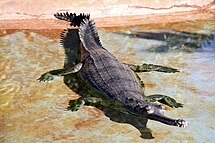Gavialidae
| Gavialidae Temporal range: Eocene,
| |
|---|---|

| |
| Indian gharial, Gavialis gangeticus | |
| Scientific classification | |
| Domain: | Eukaryota |
| Kingdom: | Animalia |
| Phylum: | Chordata |
| Class: | Reptilia |
| Clade: | Archosauromorpha |
| Clade: | Archosauriformes |
| Order: | Crocodilia |
| Superfamily: | Gavialoidea |
| Family: | Gavialidae |
| Subgroups | |
Gavialidae is a family of reptiles within the order Crocodilia. Gavialidae have conventionally consisted of only one surviving species, the gharial (Gavialis gangeticus), which is native to India and Nepal. Many extinct species are also known. The false gharial (Tomistoma schlegelii) has usually been thought to be a member of the family Crocodylidae based on several characters including skull morphology, but has sometimes been viewed as a member of this family due to general similarities in morphology and habit. However, numerous molecular studies have consistently shown the two species to be very closely related, supporting the view that they are in the same family.[1]
Gavialids are large semiaquatic reptiles, resembling crocodiles, but with much thinner snouts. The thin snout is used to catch fish, as gavialids lack the jaw strength to capture the large mammalian prey favoured by crocodiles and alligators of similar size.[2]
Taxonomy
Family Gavialidae
- Subfamily Gavialinae
- Genus †Eogavialis
- Genus Gavialis
- Gavialis gangeticus, gharial
- Subfamily †Gryposuchinae
- Genus †Aktiogavialis
- Genus †Gryposuchus
- Genus †Ikanogavialis
- Genus †Siquisiquesuchus
- Genus †Piscogavialis
- Genus †Hesperogavialis
In addition, molecular evidence indicates that the tomistomines belong to this group, although morphological evidence has been cited to place them in Crocodylidae:
- Subfamily Tomistominae
- Genus †Kentisuchus
- Genus †Gavialosuchus
- Genus †Paratomistoma
- Genus †Thecachampsa
- Genus †Rhamphosuchus
- Genus Tomistoma
- Tomistoma schlegelii, false gharial or Malayan gharial
- †Tomistoma? lusitanicum
- †Tomistoma cairense
- Genus †Toyotamaphimeia
Species (Extant)
-
Gharial (Gavialis gangeticus)
-
False gharial (Tomistoma schlegelii)
† Indicates extinct group
References
- ^ Willis, R. E.; McAliley, L. R.; Neeley, E. D.; Densmore Ld, L. D. (June 2007). "Evidence for placing the false gharial (Tomistoma schlegelii) into the family Gavialidae: Inferences from nuclear gene sequences". Molecular Phylogenetics and Evolution. 43 (3): 787–794. doi:10.1016/j.ympev.2007.02.005. PMID 17433721.
- ^ Magnusson, William E. (1998). Cogger, H.G. & Zweifel, R.G. (ed.). Encyclopedia of Reptiles and Amphibians. San Diego: Academic Press. pp. 229–230. ISBN 0-12-178560-2.
{{cite book}}: CS1 maint: multiple names: editors list (link)


